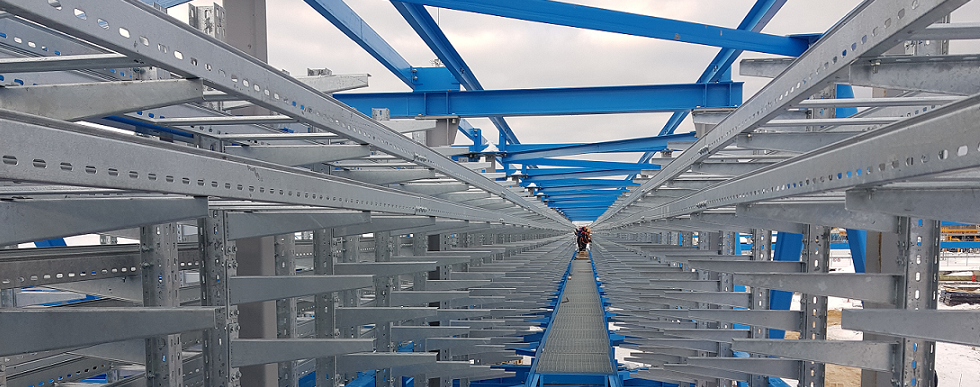- Home
- Cable Tray Solutions for Oil and Gas Industry
Cable Management Solutions for the Oil & Gas Industry

Cables help drive productivity in oil and gas facilities by supplying energy, connecting controls, and supporting systems that keep operations safe and stable. But in harsh places with heat, shaking, and chemicals, cables can get damaged if they aren’t managed properly.
That's why cable tray solutions are so valuable. They organize wires neatly and protect them from harm, helping everything run safely and efficiently.
In this blog, we'll explain what makes cable management systems essential in the energy sector, what trays are commonly used, and how choosing the right system can help you avoid problems and keep your operations running strong.
The Role of Proper Cable Support
Energy environments are tough. Cables face extreme heat, constant shaking, and chemical contact daily, making reliability a top priority. This condition leads to cable wear, overheating, and serious hazards without proper cable management. A structured cable tray system offers secure routing, prevents failures, and reduces risk. It strengthens core infrastructure, reduces the risk of system failure, and aligns with strict regulatory requirements.
For engineers and site managers, investing in reliable cable support leads to consistent uptime and greater operational safety in rugged industrial settings. Here's a closer look at why investing in the right cable support system pays off:
Risk Prevention
Exposed wiring poses serious safety concerns, from electrical contact to physical injuries caused by tripping. Installing cable tray systems keeps cables contained and away from foot traffic, promoting a safer, more compliant environment for all site personnel.
Low Maintenance
When cables are laid out in an organized and structured manner, locating problems becomes much easier. Technicians can trace wires quickly during maintenance, identify electrical faults, and perform repairs faster. This streamlines troubleshooting, reduces downtime, and enhances maintenance efficiency.
Long-Lasting Strength
Cable tray systems are engineered to withstand aggressive environments. These trays offer a long-lasting solution, whether it's high temperatures, corrosive chemicals, or constant mechanical stress. Their robust design ensures that the electrical systems remain protected and functional even in the most demanding industrial settings.
Improved Compliance
A well-structured cable tray setup is neat and compliant. Industry regulations require clear routing and secure fastening of cables to prevent failures and fire risks. Proper support systems meet these regulatory standards and simplify inspection, helping businesses avoid fines and delays.
Affordable Choice
Downtime and cable repairs can be costly. Cable trays reduce the need for frequent repairs or replacements by providing a protective framework that minimizes damage. It leads to lower maintenance costs, less operational disruption, and improved cost-efficiency.
Adaptability
Businesses grow, and so do their electrical needs. Cable trays offer the flexibility to scale. New wires can be added or rerouted without tearing down existing infrastructure. This adaptability supports future expansion and saves companies from expensive overhauls during upgrades.
Common Cable Support Methods in Oil and Gas Operations
Cable trays are the backbone of electrical routing in the energy sector. They support, protect, and guide power and signal cables in high-demand environments. Here are five essential types of cable trays used across the industry:
Ladder Trays
- Best For: High-voltage power cables across long distances
- Benefits: Excellent ventilation and load capacity
- Use Case: Offshore platforms and industrial zones
Their rung-style design reduces cable overheating and supports heavy-duty wiring with ease.
Wire Mesh Trays (Basket Trays)
- Best For: Light-duty runs and flexible routing
- Benefits: Easy to cut, shape, and install
- Use Case: Data cabling, instrumentation, and compact spaces
Wire mesh trays offer speed and flexibility, which is ideal where cable layouts change often.
Solid-Bottom Trays
- Best For: Environments exposed to dust, moisture, or chemical elements
- Benefits: Full protection and isolation
- Use Case: Refineries, compressor rooms, or chemical storage zones
They keep cables sealed off and safe from exposure.
Perforated Trays
- Best For: General-purpose use in indoor or protected outdoor areas
- Benefits: Balanced airflow and support
- Use Case: Electrical rooms, workshops, and substations
Perforated trays prevent moisture buildup while protecting cables.
Trough Trays
- Best For: Medium protection with partial enclosure
- Benefits: Stable, organized cable runs
- Use Case: Long cable paths in structured environments
They’re perfect for organizing medium-load runs where open trays might be too exposed.
Quick Tip: Always match your tray type to the cable load, environment, and level of exposure. Heavy-duty cable trays like ladder and solid-bottom types are best suited for rugged field use, while mesh trays fit fast-paced, flexible layouts.
Industries Benefiting from Cable Tray Systems
While cable support systems are crucial in the oil and gas industry, they are also widely used in other sectors:
Manufacturing Plants
Cable trays help manage and safeguard cables in manufacturing plants and power stations.
Commercial Buildings
Wire trays keep cables neat and secure in offices and retail buildings.
Infrastructure Projects
In transportation and communication projects, such as airports and railways, cable tray systems support wiring.
Choosing the Right Cable Tray Manufacturer in UAE
A reputable manufacturer offers long-lasting cable trays, lowering the possibility of breakage, outage, and expensive repairs.
Key Factors to Consider
- Material Quality: Corrosion-resistant materials for challenging conditions.
- Safety Compliance: Meeting all industry regulations and standards.
- Tailored Options: Custom designs to fit specific project needs.
BonnGulf’s Cable Tray Solutions
We provide long-lasting cable tray systems for the oil and gas industry. Our solutions are built to withstand harsh conditions, offering safety, efficiency, and customizable features to meet your unique requirements.
Conclusion
Managing cables in the oil and gas industry isn’t just about organization; it’s about keeping your people, equipment, and systems safe. The right cable tray setup supports your operations by improving airflow, preventing damage, and making future upgrades easier.
BonnGulf provides systems built to handle tough environments with the strength and flexibility your projects need.
Need help choosing the right tray system? Contact us for expert support and customized solutions.
